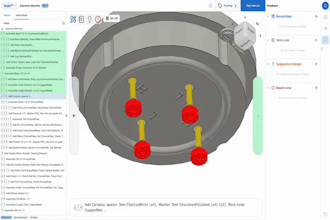
For decades, industrial maintenance strategies relied on either reactive or preventive methods. Reactive maintenance (aka “run-to-failure”) waits for equipment to break, causing costly unexpected downtime. Preventive maintenance schedules regular servicing based on time or usage to prevent unexpected downtime and logistics issues.
While preventive maintenance avoids unexpected downtime, it has significant limitations, including unnecessary maintenance tasks, labor inefficiencies and escalating costs.
As industrial operations have grown more complex and digitized, traditional methods lead to higher inefficiencies. Manufacturers lose the responsiveness required to stay competitive. This is where Artificial Intelligence (AI)-driven maintenance, specifically predictive and prescriptive maintenance strategies, offers a transformative alternative.
Predictive vs. Prescriptive Maintenance
Predictive Maintenance uses sensor data, machine learning and statistical models to anticipate equipment failures before they occur. The goal is to predict when a machine will likely fail so that maintenance can be performed just in time, not too early or too late.
Numerous sensors, such as temperature, pressure, vibration or acoustic, drive data streams from each machine. These data streams train AI models to predict failure while maximizing machine uptime and part life. This results in higher efficiency and lower maintenance costs compared to preventative schedules.
Prescriptive Maintenance goes a step further. In addition to forecasting failure, it recommends the best action to prevent it, considering cost, impact, resource availability and production schedules. While predictive maintenance asks, “When will this fail?” prescriptive maintenance asks, “What should we do about it?”
Prescriptive maintenance uses analytics to initiate automated actions or recommend actions to operators. Together, these approaches form the core of intelligent maintenance strategies that can reduce downtime, optimize asset lifespan and align maintenance operations with business goals.
Predictive Maintenance
Predictive maintenance’s value lies in timing: Doing the right work at the right time. Predictive maintenance is already transforming how factories monitor and care for critical assets. By collecting data on vibration, temperature, pressure and more from sensors, AI models can detect patterns that precede failure.
These patterns would be invisible to even the most experienced technician. Maintenance can now be scheduled during a routine downtime window, avoiding a major process disruption, reducing unplanned downtime, and increasing asset availability.
Prescriptive Maintenance
Prescriptive maintenance builds on predictive maintenance. While predictive maintenance tells you what is likely to happen, prescriptive maintenance tells you what to do about it. It uses AI to evaluate multiple intervention options and either initiate automated actions or recommend optimal decisions based on business constraints and trade-offs.
By layering in a prescriptive maintenance system, the AI can recommend specific interventions: replacing a valve immediately, deferring the task to a low-demand period, or reallocating time from lower-priority tasks before a stoppage occurs. Shifting to prescriptive guidance can improve response efficiency, reduce decision fatigue and cut operational maintenance costs.
AI-Driven Maintenance: Opportunities and Challenges
It’s a mistake to jump directly into choosing sensors and models. Successful AI deployments require a thorough understanding of all processes, needs and risks. Implementing AI in maintenance requires more than installing sensors and software. Organizations must build the proper data foundation, align teams and incorporate input from all levels. Some best practices can include:
- Start with High-Value Assets: Focus early efforts on machines whose failure leads to the most downtime or cost. Identify opportunities and challenges with each process candidate. Prioritize projects for phased implementation.
- Clean, Contextual Data is Critical: AI models demand quality data, not just data volume. Data must be labeled, structured and correlated with historical outcomes.
- Cross-Functional Collaboration: Automation, maintenance, IT and operations teams must collaborate to ensure models are aligned with real-world workflows. Build a cross-functional team to understand opportunities and challenges better.
- Continuous Learning: AI models must be monitored and updated as machines age and operations change. This workflow needs to be accounted for in deployment planning.
Some of the biggest challenges will include:
Data Silos: Legacy systems often isolate data, making integration difficult. Data for AI model training needs to be standardized, contextualized and unified for reporting.
Change Management: Shifting from reactive or preventive maintenance to AI-guided maintenance requires buy-in and retraining. Making use of the cross-functional team helps identify challenges and increase buy-in before implementation begins.
Initial Costs: Sensor installation, data infrastructure and model development can require significant investment. Understanding the upfront costs and monitoring ROI targets is a crucial aspect of a phased implementation. Detailed reporting and analysis allow adjustment or acceleration of subsequent phases as needed.
Setting expectations: Ultimately, predictive alerts must be easily accessible and clearly indicate potential failures and timelines. This accuracy comes with time as the AI models are refined, so clearly setting expectations for operators on early model performance is an important consideration.
Understanding the challenges, a disciplined and phased approach can mitigate risk and accelerate time-to-value.
Unlocking Competitive Advantage
Predictive and prescriptive maintenance represent more than an upgrade; they signal a fundamental shift in how industrial organizations think about reliability, risk and resource allocation. By using AI to anticipate problems and recommend actions, manufacturers can minimize downtime, maximize asset performance and make maintenance a strategic function.
The business environment is becoming more dynamic. Supply chains can shift quickly, and customer demands require process agility. In an era where every hour of production counts, AI-driven maintenance is not just a tool; it's a competitive advantage.
John D’Silva, Automation and Safety Technology Manager, Siemens’ Factory Automation division, will be sharing his expertise at Smart Production Solutions, a renowned global automation industry trade event, coming to the U.S. for the first time in September. John, a nearly 25-year Siemens veteran, is a member of the technical advisory committee for Mesago Messe Frankfurt, which produces SPS.






















